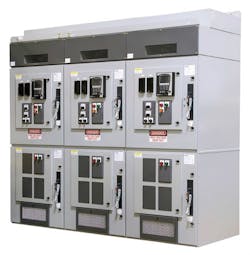Adjustable frequency drives (AFDs) are often tapped to drive energy savings in motor control applications. In medium-voltage equipment, drives can save upwards of 40 percent in annual energy consumption. Today’s drives can do much more than save energy though — providing process control, high-startup torque on weak power systems and reducing electrical and mechanical stress across the system.
In applications with more than one motor, a single drive can be configured to start any number of motors — depending on the size and layout of the system — to provide efficient, reliable motor control with a small footprint at a minimal capital investment. This application of a medium-voltage AFD is called synchronous transfer.
Synchronous control
Synchronous transfer systems maximize capital efficiency by controlling multiple motors with one AFD. In these applications, a synchronous transfer system is designed to sequentially control multiple motors in a variety of configurations to satisfy varying process needs. Examples of synchronous transfer applications include:
- Operation of motors of different horsepowers with a single drive
- Minimization of utility disturbances during motor startup on a weak power system
- Optimization of process control by regulating motor speed based on demand
- Reduction of mechanical shock and wear by soft-starting the motor and drive load
During synchronous transfer, the drive will start the initial motor, transfer the motor across the line through an adjacent bypass contactor and operate at full speed. Additional motors can be started and controlled in a similar manner, and motors can be sequentially reconnected to the drive and ramped down in the same way. It is important to note that the drive can start multiple motors, but it can only control one motor at a time.
A synchronous control system contains an AFD, a programmable logic controller (PLC), a drive output contactor, a bypass starter and motor select contactor for each motor. Solutions that are factory tested as single systems (rather than integrated at the job site) help minimize system integration risks.
Cabling versus bus connection
Traditional synchronous transfer systems use separate motor-select and bypass starter lineups that require expensive shielded power cables to be run external to the lineups. Double-bus designs can combine the motor-select and bypass starters into a single lineup that requires no external cable connections. Additionally, the drive output is routed to the selected motor through the top-mounted AFD bus to provide a simple and cost-effective design that is easier to install than cabling. A double-bus design is especially efficient in electrical houses and smaller control rooms.
Improvements through closed-transition transfer
The key performance in a synchronous transfer system is the ability to synchronize the drive output to the utility line power and provide a smooth transition when connecting the motor to the utility. Typically, some surge or other stress on the motor and load is present during this transition.
With some system designs, motors free-coast when they are switched between the drive and the utility. This method can lead to imperfect transitions and can stress the mechanical and electrical systems with torque or current surges.
Closed-transition technology provides smooth transitions during drive-to-utility transfer. During the transfer process that taps closed-transition technology, the drive matches the 60-hertz line power and closes the bypass starter before powering down the drive, preventing the motors from free-coasting during this critical time. If the system is called on to switch a motor from the utility source back to the drive (utility-to-drive), closed transition transfer can once again be applied to provide a smooth, seamless transition.
The advantage of closed-transition transfer is the reduction of stress on the motor and load, helping increase the longevity of the motor and improving the overall reliability of the system.
Best practices to drive system improvement from AFDs
AFDs have been used for decades to match motor speed to output requirements, which has yielded substantial energy savings. Drives with synchronous transfer can be used to reduce capital investments by controlling multiple motors with one drive. For these synchronous transfer applications, the design configurations that can advance system performance include:
- Integrated systems that are factory tested to minimize risks
- Double-bus design that avoids external cabling
- Closed-transition transfer from drive to utility and from utility to drive that eliminates mechanical and electrical stress.
Mike Kellis is product manager for medium-voltage control assemblies and Aaron VanderMeulen is application engineer for medium-voltage control assemblies at Eaton.



